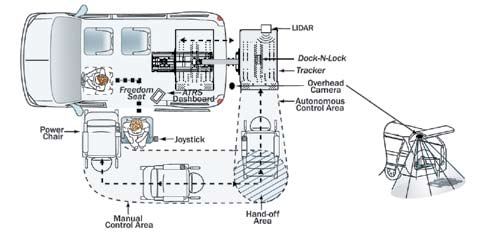Wheelchair users will soon find it safer and cheaper to drive a car, thanks to a new system that integrates robotic, laser and wireless technologies.
The Automated Transport and Retrieval System (ATRS) allows wheelchair users to get into and out of their vehicles, stow and retrieve their chairs, and drive while sitting in traditional auto seats that meet federal safety regulations.
That last improvement is critical, says John Spletzer, director of Lehigh’s Vision, Assistive Devices and Experimental Robotics (VADER) Lab.
Most existing technology requires disabled persons to sit in their wheelchairs while driving. Because they are often poorly secured, wheelchairs provide far less protection than standard seats. According to the U.S. National Highway Traffic Safety Administration, 35% of all automobile fatalities related to wheelchairs result from inadequately secured chairs.
ATRS, developed by Lehigh, Freedom Sciences LLC of Philadelphia and Freedom Lift Corp. of Green Lane, Pa., has completed the American National Standards Institute and Rehabilitative Engineering Society of North America requirements for FDA certification of medical devices. It is scheduled to go on the market this spring.
ATRS works like this:
Roll your wheelchair to the driver’s side of your van or minivan. Using a standard key fob, open the van door and direct the van to lower the driver’s seat next to your wheelchair. Now slide from your wheelchair into the driver’s seat. Using a joystick, guide your empty wheelchair to the rear of the van. There, a laser system built into the van’s rear lift platform guides the chair onto the platform and raises and stows the chair in the back of the van. While this is happening, you press another button to raise the driver’s seat, in which you are seated, up into the van, where it is locked into its driving position.
ATRS is also more convenient for disabled persons wishing to drive, says Spletzer. Because it is modular, it can be installed without making permanent changes to the vehicle. Drivers trading in their cars merely remove the ATRS components from the old vehicle and install them in the new one. Currently, disabled drivers must convert their vehicles, which can require costly adjustments to the vehicle floor, fuel lines, fuel tank, and heating and air-conditioning systems. ATRS will also cost significantly less than a van conversion.
Freedom Sciences has signed a licensing agreement on ATRS with Lehigh. Engineers have done extensive testing to verify the system’s reliability under different environmental conditions, and to characterize its “operational envelope” on different road surfaces.

